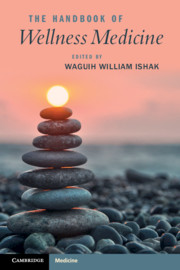Book contents
- The Handbook of Wellness Medicine
- The Handbook of Wellness Medicine
- Copyright page
- Dedication
- Contents
- Contributors
- Part I Approach to Wellness
- Part II From Illness to Wellness by Organ Systems/Disorders
- Part III Special Populations and Special Topics
- Part IV Wellness Interventions
- Part V Wellness through Optimization of Work, Love, and Play
- Chapter 45 Work, Love, Play, and Joie de Vivre
- Chapter 46 Well-Being and Work–Life Balance
- Chapter 47 Family Relations, Friendships, and Love
- Chapter 48 The Role of Leisure, Recreation, and Play in Health and Well-Being
- Chapter 49 Wellness and Whole-Person Care
- Chapter 50 The Personalized Wellness Life Plan
- Book part
- Index
- References
Chapter 49 - Wellness and Whole-Person Care
from Part V - Wellness through Optimization of Work, Love, and Play
Published online by Cambridge University Press: 18 September 2020
- The Handbook of Wellness Medicine
- The Handbook of Wellness Medicine
- Copyright page
- Dedication
- Contents
- Contributors
- Part I Approach to Wellness
- Part II From Illness to Wellness by Organ Systems/Disorders
- Part III Special Populations and Special Topics
- Part IV Wellness Interventions
- Part V Wellness through Optimization of Work, Love, and Play
- Chapter 45 Work, Love, Play, and Joie de Vivre
- Chapter 46 Well-Being and Work–Life Balance
- Chapter 47 Family Relations, Friendships, and Love
- Chapter 48 The Role of Leisure, Recreation, and Play in Health and Well-Being
- Chapter 49 Wellness and Whole-Person Care
- Chapter 50 The Personalized Wellness Life Plan
- Book part
- Index
- References
Summary
Whole-person care is medical or other care that includes separating the person from the problem, taking measures to cure or prevent the problem or disease, and facilitating and supporting healing [1]. This is the approach to wellness taken in this chapter. There are three ways to imagine whole-person care interventions that might affect wellness.
The first is the reductionist approach that divides a whole person into their many component parts, identifies the location of the problem that is interfering with wellness, and takes appropriate measures to alleviate or fix the problem. There is a lot to be said for this approach. If I have a toothache that is interfering with my sense of wellness, I want that problem identified and fixed. I would want a physician or other healthcare professional caring for me to be able to deliver this kind of care or to refer me to someone who could deliver this care.
- Type
- Chapter
- Information
- The Handbook of Wellness Medicine , pp. 573 - 581Publisher: Cambridge University PressPrint publication year: 2020



